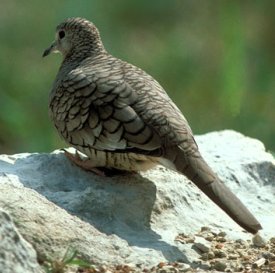Inca Dove (Columbina inca)

TPWD ©
- Description
- Inca doves are tiny gray pigeon-like birds with long tails. Their outer tail feathers are white. They have rusty wing patches easily seen when they fly. Inca's have a distinctive fish scale pattern on their breast, head and back feathers.
- Life History
- This common Southwest species is one of the most desert-adapted of the family. Its plump body can survive both extreme heat and cold. They can go four or five days without drinking, and fly 10 or more miles to reach a water hole.
Their melodious "hoo hoo" repeated up to 30 times a minute fills the air during early summer. These doves are almost always seen in pairs. Their scaly appearance sets them apart from other small doves. In the winter, Inca doves gather in flocks of up to 50. On cold winter days they have been known to form pyramids 2 or 3 tiers high in order to stay warm.
During courtship, the male inca dove bows, coos and struts in front of the female, fanning his tail feathers. Males battle furiously for females. Dove nests are a flimsy basket of sticks barely woven together. Dove and pigeon nestlings are fed "pigeon milk" a high protein milky substance produced and regurgitated by their parents.
Inca doves seem to be increasing in areas of human disturbance. These seed-eating doves are common visitors to bird feeders. With their soft cooing calls, males strutting for females and their regular use of bird feeders, inca doves have quickly become back yard favorites. - Habitat
- Their preferred habitat includes urban and suburban settings, woodland edges, savannahs, and thickets in and around cultivated fields.
- Distribution
- Inca doves are found from south-central Texas, Arizona and New Mexico south to Mexico and Costa Rica.
- Other
- Because they fly directly to water, with no searching about, early west Texas travelers would often watch doves to locate water holes.